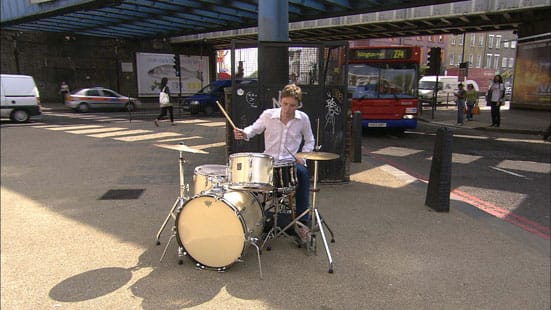27th April 2007 — 17th June 2007
(1),
The Soundtrack, a film and light-box work specially commissioned by
Cubitt, is the first UK solo show by Swedish artist Annika Eriksson.
The narrative behind the piece, we are told, is of a musician in search
of a band, finding an unlikely collaborator in the cacophony of
London's anxious landscapes.
(2) The sound was off when I visited the space. The door to
the gallery office was ajar, the noise of two women with
work-in-the-arts accents conversing being the only soundtrack provided
over the muted drummer. I didn't mind too much. It allowed me time to
work out the location to this scene in silence: a relatively large
public space at a busy junction in Camden, central London. I knew this
place well. I had my scooter smashed up just to the right of the
drummer. 'Would you like the sound up?, 'I would, yes.' 'Betina, we
have a very quiet visitor!'
(3) The press release claims that we may imagine this
performance as 'a meditation on the way in which a city might interact
with its inhabitants'. However, the performer here doesn't seem to be
sensitive enough to his band mate. The sonic landscape of the city is a
backdrop, far from a participant, and there is little tension between
the two. Rather, the over-emphasis on the drums in the soundtrack
renders all background noise almost inaudible. Perhaps this is
Erikksson's intention. Drummers are more often than not relegated to
the rear of any stage configuration, making up the 'back line'. Here,
he is out in front, centre stage, playing his tentative 4/4 beats - in
my mind, ill-fitting for an area renowned for the maniacal steel on
steel shriek of cab brakes and thunder of countless juggernauts.
(3.1) I saw Omar Hakim play a drumming workshop in Edinburgh
in the late 90s. He was asked to give a rendition of Bowie's China
Girl, which he had originally recorded on. He fell into his kit with
vim. There was only one man on stage, no accompaniment, yet everyone
could hear the whole band. Perhaps in their absence, all the more so.
(4) The lightbox reiterates the idea of public space as
'potential' space, whether that be economic, social or creative. All
the images here are devoid of any human presence, implying that these
spaces are failing to fulfill this potential. Empty street corners,
empty building sites, and public benches are highlighted by those great
signifiers of the parameters of dead urban space; hoardings, cordons,
fences, bollards, and of course, barbed wire. In short, these are
places men seek out in which to urinate publicly.
(4.1) Traditionally, these spaces can be seen as testing grounds for
young men, places of uncertainty where one can carve out ideas, take
risks, piss against the wall. Much in the same vain as Tarkovsky's Zone
in Stalker, a visit to post-industrial landscapes or 'wasted' space
(both in the sense of neglected and used up) allows introspection, to
understand where one exists between things. Indeed, these spaces that
Eriksson brings to our attention are the in-between, the residual
spaces leftover by architects and town-planners. I'm not sure how much
she actually adds to this notion of shrinking public space, especially
considering she is giving us clear proof that, irrespective of scale,
non-designated public space seems to be consistent throughout time. The
developer needs to curtail the dead space, to dock it and keep it to an
optimum size to resist it ending up as the terrain vague, or a place of
lost potential.
(5) Not to sound too curmudgeonly, that place he's drumming
in, it's one of the few uninterrupted spots of the city where there is
a brief moment of space - nothing more. In such a cluttered area, where
the stench of other people's food and hot ammonia emanating from the
spit-stained streets, and the full range of audible frequencies can be
heard at any one time, I'm all for a little peace. It all seems a
little forced. Eriksson's work here offers a layer on a layer on a
layer on a layer and adds more flab to an already over-produced
soundtrack.
SP
CUBITT
8 Angel Mews
London N1 9HH
http://www.cubittartists.org.uk/
Open
Wednesday-Sunday, 12-6pm

Annika Eriksson
The Soundtrack
2007